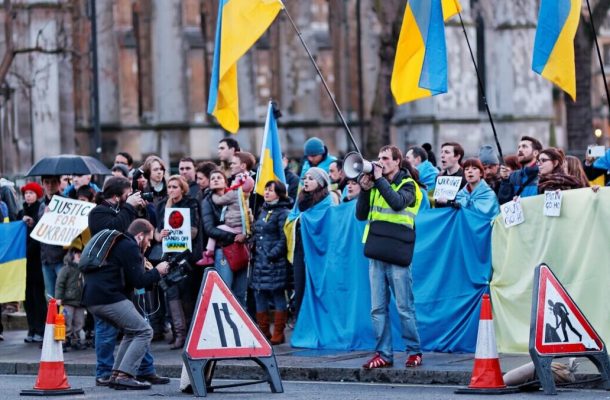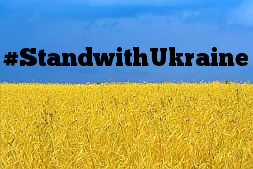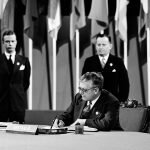The West’s weakness spurred Putin’s gamble

Eight years on from Moscow’s successful annexation of Crimea and the beginning of the protracted war in Donbas, President Vladimir Putin launched a full offensive against Kyiv. The risks of the Russo-Ukrainian conflict escalating to all-out war have simmered in the background ever since the events of 2014.
However, Russian strategy during its Crimean campaign ensured that neither Ukraine nor the West was given the chance to respond decisively. Moscow’s decision to execute an overt full-scale military manoeuvre against Kyiv is a significant breakaway from this behaviour.
After years of unsuccessful negotiations, Russia’s decision to engage in an all-out war was at last driven by its desperation to prevent Ukraine from joining the North Atlantic Treaty Organization (NATO) and the security implications of sharing a border with an alliance member that would follow. However, Russia’s Crimean campaign eight years ago also exposed gaps in Western deterrence that Moscow realised it can exploit.
President Putin is risking that a full military invasion of Ukraine will be again met by the Western powers’ disinclination to respond decisively on short notice, allowing him to negotiate in an advantageous position after toppling the leadership in Kyiv. Regardless of how this war progresses, one thing is certain — the Western powers failed to deter Moscow’s escalation to war just as they failed to deter Moscow from annexing Crimea in 2014.
The 2014 Annexation of Crimea
The fact Moscow succeeded in its 2014 Crimean operation without encountering any formidable resistance no doubt factored into its decision to escalate the current conflict. Non-military operations predominated the Russian strategy and were used to shape the conflict environment. This was followed by a limited military operation to rapidly secure Moscow’s strategic objective of annexing the peninsula.
While Russian cyberattacks and disinformation began in early 2013, the removal of Viktor Yanukovych on 22 February 2014 from presidency amidst the intensifying political tensions in Ukraine marked the beginning of the escalation. On 27 February 2014, plain-clothed military personnel — dubbed by the locals as “little green men” and later identified as Russian special forces — started seizing critical civil and military infrastructures in Crimea such as its parliament, media stations, and military bases. That effectively isolated the peninsula and facilitated the entry of Russian reinforcements.
Coinciding with these operations, Moscow postured its military forces for escalation. On 26 February 2014, 150,000 military personnel from Russia’s Western and Central Military District were ordered to conduct a snap exercise.
The activity was used as a cover for the movement of 40,000 military personnel to Anapa, a staging area east of Crimea, and distracted Western observers away from the ongoing seizure operations. Moreover, it empowered President Putin to suggestively escalate the conflict to an all-out war if either Ukraine or the West decided to respond militarily.
Moscow’s state-owned media engaged in a massive disinformation campaign portraying a distorted image of the conflict wherein the seizure operations were attributed to pro-Russian separatists. While this narrative presented the conflict as a legitimate separatist movement and materialised a potential legal pretext for Moscow’s intervention, President Putin denied any Russian involvement. On 18 March 2014, Moscow ratified Crimea’s annexation.
Gaps in the West’s Deterrence
Russia’s success in Crimea can be attributed to its effective use of what Prof Dr. David Kilcullen referred to as the liminal zone. The liminal zone, a concept from David Kilcullen’s theory of liminal warfare, refers to the overlapping space between clandestine and overt operations.
This transitional space is where a defender undergoes the process of detecting, attributing, and responding to an attack. An aggressor can take advantage of this temporal space to rapidly secure strategic objectives before a defender can react, allowing it to de-escalate the conflict and negotiate in an advantageous position.
Similar to its approach during the Russo-Georgian War of 2008, Moscow exploited the liminal zone in Crimea. Moscow expanded the conflict’s liminal zone through disinformation, suggestive escalation, and denial of involvement to obfuscate its objectives from Ukraine and the West.
It then conducted a limited but decisive military operation to rapidly isolate the peninsula before its intents had been ascertained and a decisive response can be established. Finally, Moscow quickly de-escalated the conflict by consolidating its strategic gains through a constitutional pretext by ratifying the treaty of annexation.
Russia’s strategy underlined the gaps in the West’s deterrence policy particularly its high response threshold and lack of potential response options against some coercive operations. As noted by Kilcullen, the Western powers’ high response threshold can be attributed to constraints posed by politico-legal processes in democracies which require adherence to democratic processes, international norms and laws, and in the case of security organisations, consensus prior to collective action before responding.
Even if response thresholds can be adjusted to match these types of threats, it is still unclear how proportionality should be interpreted vis-à-vis sub-conventional and non-kinetic operations given their deniability and lagged effects. Miscalculating what constitutes a proportional response is risking unwanted escalation.
These issues had been apparent with the hesitation of the West to immediately enact decisive punishment against Russia in 2014. Evidence suggests that Russia’s shaping operations and its ambiguous involvement and intents factored in the hesitance of Kyiv and the Western powers to respond militarily.
To avoid giving Moscow a pretext to escalate, the response of the Western powers immediately following the annexation had been limited to economic and diplomatic sanctions. These shortcomings tarnished the Western powers’ credibility to defend Ukraine against Russian aggression.
Putin’s Gamble
Moscow expected that the same vulnerabilities could be exploited again, this time for the more significant strategic objective of invading Ukraine. It employed a similar pattern of aggression leading to and during its invasion of the post-Soviet state, albeit with limited success. Prior to the escalation early this year, Moscow employed disinformation, cyberattacks, denial of intent, and suggestive escalation as it did in Crimea. While it appears that Moscow’s disinformation campaign and cyberattacks have not yet significantly affected Ukraine’s capacity to defend itself, its suggestive escalatory actions, in the early months of 2021 and again in the closing months of the same year, through its military mobilisation, gave it an initial operational advantage. It allowed the Russian military to gradually position its assets near the Ukrainian border in preparation for an invasion without significant hindrance.
However, Russia’s military invasion failed to rapidly secure its objective of capturing Kyiv. Aside from the formidable Ukrainian resistance, Russian forces had been plagued with severe logistical problems, lack of combined arms coordination, and low morale, among others. While some of these problems had been observed during previous Russian military operations, particularly in Georgia, it also shows that Moscow was expecting a rapid military victory in Ukraine and not a protracted war.
Russia’s failure to achieve a rapid and decisive victory, without doubt, bids well for Ukraine and the West. It does not discount the fact, however, that the invasion would probably not have occurred if Moscow had been met resistance when crossing the red lines in Crimea eight years ago. The West’s tarnished credibility was a primary driver of Moscow’s bold strategic move.
This article was published by the Australian Institute for International Affairs.
Karl Ragas graduated with a Master’s degree in International Relations and National Security from Curtin University and holds an undergraduate degree in Applied Economics from De La Salle University. His master’s dissertation explored hybrid warfare strategies in the Russian annexation of Crimea in 2014.










